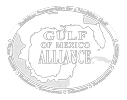The purpose of this analysis was to assess the risk of sea-level rise on current conservation areas within the coastal zone of the Gulf of Mexico by conducting a GIS analysis to determine the percent of each conservation area that would potentially be inundated from 1 or 2 meters (3.3 or 6.6 feet) of sea-level rise. The analysis assessed conservation areas at three levels, which consisted of federal, state, and private lands owned by The Nature Conservancy. As well as assessing these conservation areas, the analysis determined the amount of area that would potentially be inundated by sea-level rise within each of the 16 conservation priority areas in the Northern Gulf of Mexico Ecoregional Assessment.
Conservation and Resilience Analyses
These spatial analyses used the SLR scenarios to assess the ecological and socioeconomic components at risk of such climate hazards in each of the project sites, as well as what could be considered future conservation priorities to build a resilient coastal zone. Assessments of the impacts of SLR include the habitats (mostly coastal marshes including salt marshes and sea grass) that are at risk of inundation for each scenario, and marshes within existing management areas (protected/managed) that are at risk of inundation. These analyses relate marsh advancement zones to already place-based priorities on land.





